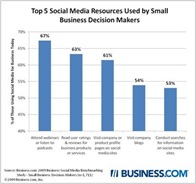An Easy Social Media Lesson From The Peanuts: Talk With Me, Not At Me
 One of the most famous cartoon dynamics could pretty much sum up the difference between successful social marketing and unsuccessful social marketing: The Peanuts. I’m sure you recall that when the grown ups are talking at the children, all the children hear are muffled, annoying sounds. But when the children are talking with each other, they are interactive, listening and clear with one another.
One of the most famous cartoon dynamics could pretty much sum up the difference between successful social marketing and unsuccessful social marketing: The Peanuts. I’m sure you recall that when the grown ups are talking at the children, all the children hear are muffled, annoying sounds. But when the children are talking with each other, they are interactive, listening and clear with one another.
A lot of what we spend our time talking with clients and prospects about in meetings these days is social media. Obviously, it’s the hot new buzzword, especially in marketing and PR, and many companies are still trying to figure it all out: “Is it necessary for us, how will it help us, who should manage it, are we doing okay with our current presence?”
Most of the time, the companies we speak with have some sort of presence started in social networks – usually, with one of the more popular and well-known networks such as Facebook or Linkedin. Maybe they’ve posted a few photos on Flickr and some videos on YouTube. They’ve taken steps to establish accounts and make a few updates, or they might even be quite active on Twitter. But most of the time – if they’re asking for help – they lack the “Three I’s” – a strategy for integration, interaction and intriguing content.
Here’s a simple way to get started on a strategy that involves the three I’s – and ensures that your messages don’t come across like a Peanuts parent:
- Social media is about community
- Community is about relationships
- Relationships involve hard work, consistent communication, trust, and emotion
If you keep these elements in mind, you’ll begin to see the subtle – yet important – differences between talking at your audiences and talking with your audiences. People tend to listen more – and remember more – when they’re involved in the conversation and you show that you care about them – either by asking their opinion, mentioning something relevant to them or connecting in a unique (intriguing) way. You can’t build a relationship – or a community – if you do all the talking (you know, like those Twitter accounts that are just links to a company’s news releases, or a Facebook fan page that never actually involves the fans.)
How are you integrating social media into your marketing plan to talk with your constituents and not just at them? Are you asking questions? Responding to answers? Listening to opinions? Have you integrated your content across networks to ensure an ongoing and compelling brand story? Are you putting the right resources behind your social media efforts to build a community and relationships? Step back and take a look – making some minor changes in your approach can make a huge difference in your success.


 6 marketing opportunities on Foursquare
6 marketing opportunities on Foursquare

 Coke drops campaign sites in favor of social media
Coke drops campaign sites in favor of social media